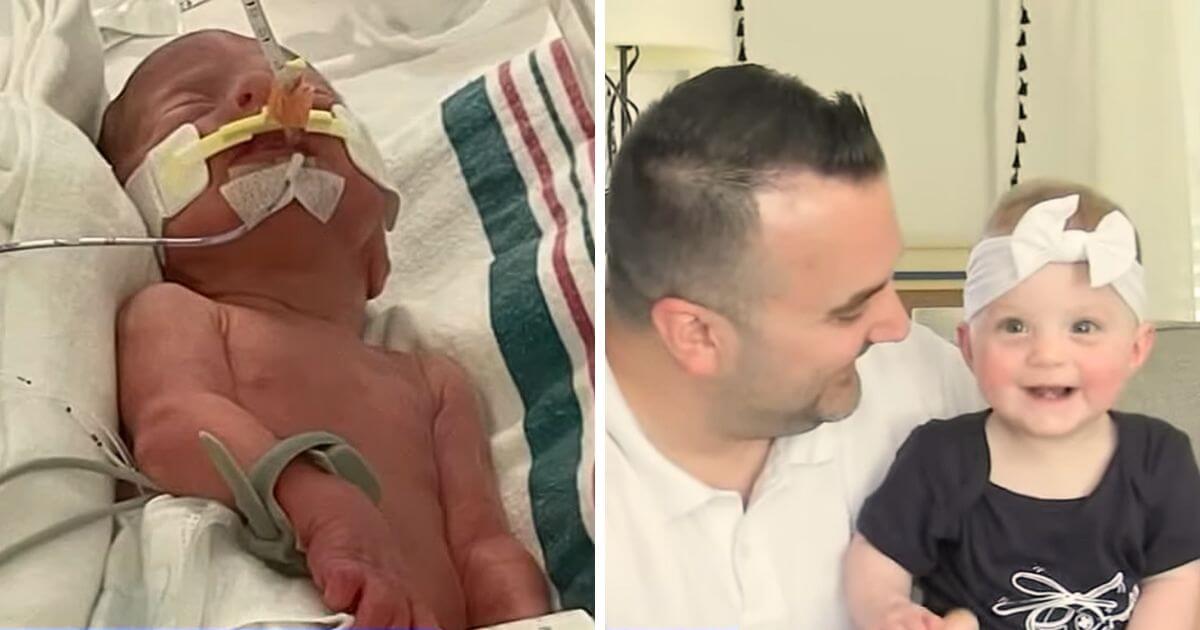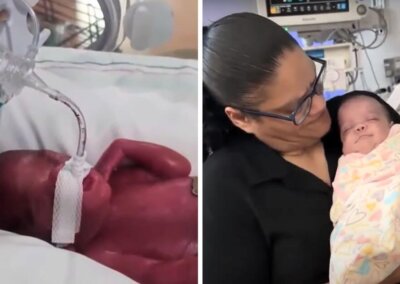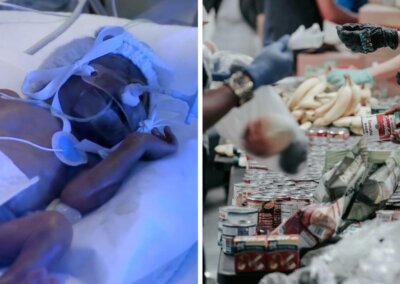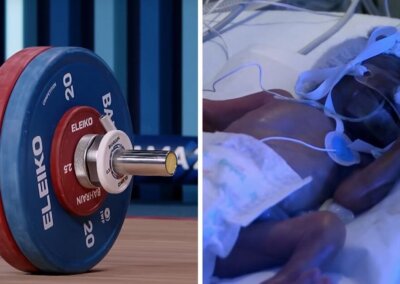A baby girl unexpectedly born abroad has celebrated her first birthday after having to be airlifted back to the United States to receive treatment.
Parents Joe and Lindsey from Pennsylvania were taking a babymoon holiday in Turks and Caicos Islands when Lindsey unexpectedly went into labour at just 27 weeks gestation. Baby Logan was delivered via emergency caesarean-section weighing just 2.5lbs.
“When [she was] in surgery, I think that was the point in time when I genuinely thought I was losing my unborn child and my wife”, Joe said.
“The medical care we had in Turks was amazing”, said Lindsey. “They took such good care of me, and honestly, they saved [Logan] and kept her stable”.
Logan was in need of more specialist care
With only one hospital in Turks and Caicos with only one ventilator available, the advanced medical care that Logan needed was not possible on the island. Her father Joe spent hours contacting insurance providers and paediatricians.
“I’ve been a firefighter for 19 years. I’ve been through crazy chaotic situations, and that had me feeling helpless”, Joe said.
“You’re basically just in full fear and panic mode for 48 straight hours”, he added.
Ultimately, Joe contacted the Children’s Hospital of Philadelphia (CHOP) and got through to the emergency transport team.
“The doctor was like, ‘I’m sorry, who are you?'” Lindsey recalled. “My husband was like, ‘I just had a baby in Turks and Caicos, and we need to get her off the island!'”
The CHOP emergency transport team sent a small aeroplane that arrived on Mothers’ Day to collect baby Logan and her father.
“You could see the relief in his eyes that someone was here to bring his baby back safely”, said Lauren Silvestro, one of CHOP’s emergency transport team.
Lindsey had to take a commercial flight back to Philadelphia that afternoon rather than going with her daughter.
“I didn’t have another choice”, Lindsey said. “I was doubled over on the plane, but I needed to get out of the country … Basically everybody knew my story by the end of the flight, because I was just sobbing”.
Travelling by plane with a premature baby was a challenge
Silvestro explained “We have to prepare for the worst. What happens if the baby loses its heart rate? What happens if the baby loses the airway?”
“We talked to the baby: ‘We’re going to get you back to mom, mom’s waiting for you at home, you’re going to meet all your family. Dad is here with you’”, she recalled.
Dr Nicholas Tsarouhas, senior medical director of the CHOP’s transport team, elaborated: “You’re in a helicopter or an airplane, and it’s you and your partner with a critically ill patient, and you don’t have backup, and you don’t have calmness around you. … You’re trying to manage a critically ill baby, to listen to heart sounds and breath sounds, and if there’s a decompensation, it’s really you and your partner”.
When Logan did make it safely back to Philadelphia, she was taken to the neonatal intensive care unit (NICU) where she was looked after for over 70 days before she went home.
“I think we were the only people in the NICU that actually were so happy to be there, which is such a weird thing to say”, Lindsey said. “But we were so happy to be there, because she was alive and taken care of by CHOP doctors”.
Logan is now one year old and is thriving at home with her older brother Cole.
“I think we’re better people for it. It’s allowed us to really take a step back and give other people more grace”, Lindsey said.
“When I was walking around town as a shell of a human when my daughter was in the NICU, and I was recovering from a C-section, people were just nice to me, and it’s kind of helped me realise – we don’t know what people are going through”, she went on. “No one knew what I was going through, and they were nice, and I just remember those things”.
It has been over 30 years since the time limit for abortion was last updated
At 27 weeks, Logan was born before the original UK abortion limit of 28 weeks. The time limit of 24 weeks for abortions performed under section 1(1)(a) of the Abortion Act 1967, was introduced by section 37 of the Human Fertilisation and Embryology Act 1990.
Prior to this change, the abortion limit had, de facto, been 28 weeks gestation set by the Infant Life (Preservation) Act 1929, which made it illegal to “destroy the life of a child capable of being born alive”.
The introduction of a 24-week gestational limit in 1990 was significantly motivated by the results of a Royal College of Obstetricians and Gynaecologists (RCOG) working party report on neonatal survival rates, which noted improvements in survival rates before 28 weeks of gestation.
During the debates ahead of the Human Fertilisation and Embryology Act 1990 becoming law, MPs referred to medical advances that had led to improved neonatal survival rates before 28 weeks gestation and the need for a reduction from 28 weeks.
Similarly, when the question of abortion time limits was revisited in 2008, the lowering of the abortion time limit in 1990 was again linked to the increased survival rates for babies born before 28 weeks gestation.
Spokesperson for Right To Life UK Catherine Robinson said “This amazing story shows the lengths to which parents and medical professionals can go to protect the lives of premature babies. We must make sure that this level of dedication and care is provided to all human lives, inside and outside of the womb”.












